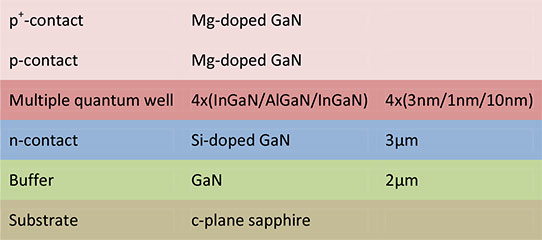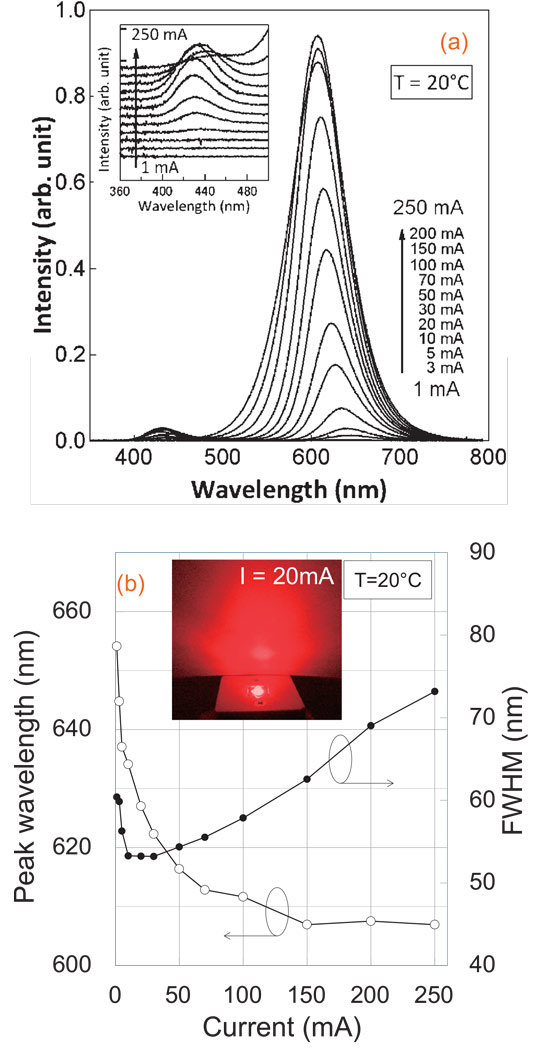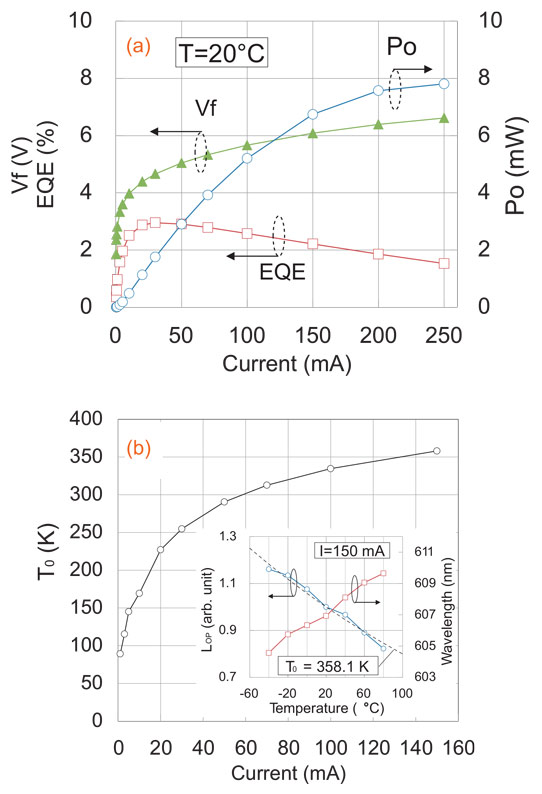- News
24 July 2014
Toshiba red InGaN LED achieves 1.1mW at 20mA injection
Toshiba Corp has developed red light-emitting diodes (LEDs) with indium gallium nitride (InGaN) multiple quantum wells (MQWs), achieving light output power (LOP) of 1.1mW at 20mA injection current [Jong-Il Hwang, et al, Appl. Phys. Express, vol7, p071003, 2014]. The researchers comment: “To the best of our knowledge, this is the first demonstration of a nitride-based red LED with the LOP exceeding 1mW operating at 20mA.” At 250mA, the output power was 7.8mW.
The semiconductor material for the nitride-based red LED (Figure 1) was grown using metal-organic chemical vapor deposition (MOCVD) at atmospheric pressure (760Torr). The MQW active region included an aluminium gallium nitride (AlGaN) interlayer (IL) between the InGaN well and barrier. The growth temperatures of the InGaN well and AlGaN interlayer were 755°C, while the barrier was grown at 100°C higher.

Figure 1: Heterostructure for red LED.
The well’s indium content was estimated at 35% and that of the barrier at less than 1%. Two LED material structure types were produced with interlayer aluminium contents of 30% or 90%. The higher-Al-content LED was found to result in lower defect densities in the active region. The researchers think that the improvement could be due to strain compensation, “although further study is needed”. The LED devices were therefore fabricated from the material with a 90%-Al interlayer.
The LED structure consisted of p-type indium tin oxide (ITO) transparent contact and titanium/platinum/gold n-type electrode. The researchers estimated a 60% light extraction efficiency through ray tracing. The 460μmx460μm LED was encapsulated in a molded silicon resin and packaged.
Spectral analysis of the electroluminescence showed a main red-light peak at greater than 600nm wavelength and some weak emission at 430nm (Figure 2). The weak emission was attributed to phase separation effects where the InGaN well material does not have a uniform alloy composition. Fortunately, the weak emission was “negligibly small”. The researchers comment: “This indicates that the phase separation in the InGaN QW was effectively suppressed in the present red LED”.

Figure 2: Electroluminescence (EL) properties of red LED with 90% Al content of AlGaN interlayer. (a) EL spectra measured at each injection current level. (b) Peak wavelength and FWHM of spectrum (inset: emission image of a red LED measured at 20mA).
At the usual low current injection value of 20mA, the peak wavelength was 629nm with a full-width at half-maximum (FWHM) of 53nm. At higher current the peak shifted towards the blue end of the spectrum with the FWHM narrowing up to 30mA. The blue shift was attributed to carrier screening of polarization fields and band-filling effects.
Above 150mA, the peak stopped shifting, remaining around 607nm. At high current the FWHM increased due to thermal effects. Thermal effects also have a red-shifting effect on the bandgap and could compensate the blue-shifting tendencies above 150mA.
Along with the light output power (LOP) at 1.1mW, the external quantum efficiency (EQE) of 2.9% was at 20mA injection (Figure 3). The forward voltage was 4.4V at 20mA and 1.9V at 0.1mA. The 1.9V value is comparable to the potential needed for the red emission at that current (~1.9eV for 0.65μm wavelength).

Figure 3: Light output power (LOP), external quantum efficiency (EQE), forward voltage (Vf), and characteristic temperture (T0) properties as functions of injection current. (a) LOP (open circle), EQE (open square), and Vf (filled triangle). (b) T0 values. Inset: temperature dependence of LOP and wavelength measured at 150mA. Dashed line indicates calculation based on intensity formula proportional to exp[T/T0] relative to base measurement at 20°C and with T0 358.1K.
The researchers also made measurements with different ambient temperature conditions and found a thermal droop characteristic temperature (T0) for light output power that varied with current injection. The larger T0 at high current indicates weaker temperature dependence since the thermal degradation effect is self-generated.
The researchers believe that further performance improvement can be achieved through “suppression of defect generation in the active layer by optimizing the local structure as well as the growth condition”.
Red LEDs Toshiba InGaN LEDs InGaN AlGaN MOCVD
http://dx.doi.org/10.7567/APEX.7.071003
The author Mike Cooke is a freelance technology journalist who has worked in the semiconductor and advanced technology sectors since 1997.


